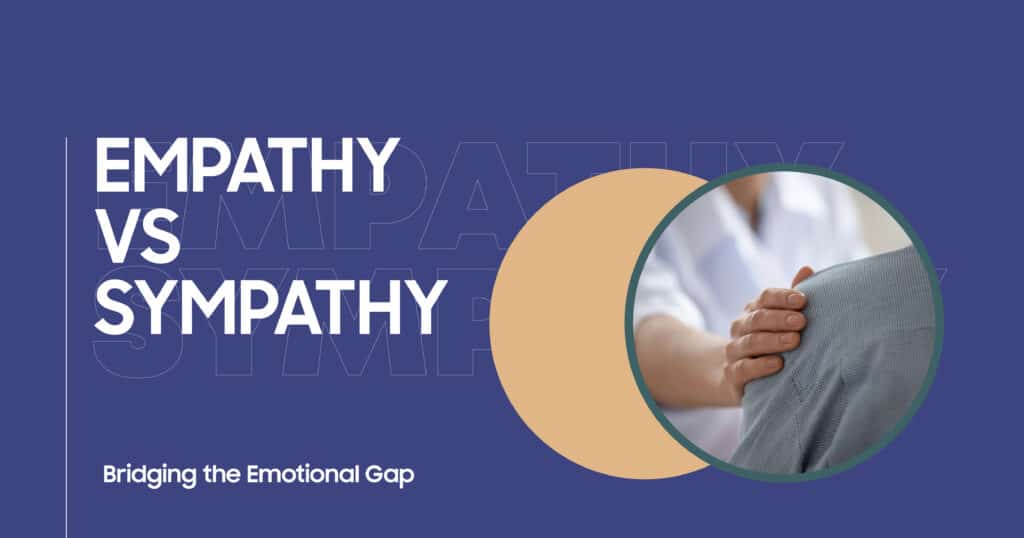In today’s world, emotional intelligence has become more critical than ever, especially in navigating personal relationships and providing support in times of need. Yet, many often confuse the terms empathy and sympathy, using them interchangeably without realizing their distinct meanings and roles in human connection.
While both are essential in expressing care and concern, understanding the difference between empathy vs sympathy can significantly enhance our emotional interactions, especially in a professional setting or when helping others through difficult times.
Studies show that 90% of people prefer to feel understood over being pitied during challenging moments, highlighting how important empathy is in fostering meaningful relationships. In contrast, sympathy, though well-intentioned, can sometimes create a sense of distance, making individuals feel isolated or misunderstood. As we dive into this topic, we’ll explore how each emotional response impacts our interactions, how we can use them effectively, and why bridging the emotional gap is vital for both personal and professional growth.
Definition of Empathy and Sympathy
To truly understand the emotional gap between empathy and sympathy, we need to define each term clearly, because while they are often used interchangeably, they represent two very different emotional responses.
Empathy is the ability to understand and share the feelings of another person. It’s about stepping into someone else’s shoes, seeing the world from their perspective, and feeling what they feel. Empathy involves connection, it’s saying, “I’ve been there, I understand, and I’m here with you.” It doesn’t necessarily mean you’ve experienced the same thing, but it does mean you can imagine how it must feel.
Sympathy, on the other hand, is recognizing someone else’s suffering and feeling sorrow or concern for them. It’s a more distant form of care, saying, “I feel sorry for you,” without truly engaging with the person’s emotions. Sympathy often comes from a place of compassion, but it lacks the deep emotional resonance that empathy provides.
While both empathy and sympathy are emotional responses to another person’s hardship, only empathy bridges the emotional gap by fostering understanding and connection. Learning to be more empathetic can lead to stronger relationships, better communication, and a more compassionate society.
Historical Context and Evolution of Empathy and Sympathy
The concepts of empathy and sympathy have deep roots in human history, philosophy, and psychology. While these emotional responses feel natural today, their meanings and interpretations have evolved significantly over time.
The word sympathy comes from the Greek word sympatheia, meaning “fellow feeling” or “shared suffering.” It was used as early as the 16th century to describe a sense of pity or sorrow for someone else’s misfortune. Philosophers like David Hume and Adam Smith explored the idea of sympathy as a foundation for moral behavior, believing that our ability to feel concern for others helps shape our ethical decisions.
Empathy, however, is a more recent term. It emerged in the early 20th century, translated from the German word Einfühlung, which means “feeling into.” Originally used in the field of aesthetics to describe how people emotionally respond to art, empathy later gained importance in psychology and social sciences. In the 1950s, psychologists like Carl Rogers emphasized empathy as a core component of effective therapy, shifting it from a philosophical idea to a vital tool for emotional connection.
As society evolved, so did our understanding of these emotions:
- In earlier times, sympathy was more acceptable and often expected, especially in religious or charitable contexts.
- In modern times, empathy has taken center stage, particularly in mental health, education, leadership, and healthcare, where deeper emotional understanding is essential for trust and healing.
Psychological Perspectives on Empathy vs Sympathy
From a psychological standpoint, empathy and sympathy are both emotional responses to the experiences of others, but they activate different processes in the brain and influence behavior in unique ways.
Empathy involves mentally and emotionally placing yourself in someone else’s situation. It’s about feeling with another person and truly understanding their emotional experience. Psychologists consider empathy a complex process that includes emotional resonance, cognitive understanding, and sometimes even physical mirroring.
Sympathy, on the other hand, is more about feeling for someone, expressing concern or sorrow without necessarily sharing their emotional experience. It is often seen as a more distant or external reaction, and while it can be comforting, it may unintentionally create a power imbalance or emotional detachment.
Here’s a table comparing the psychological perspectives of both:
| Aspect | Empathy | Sympathy |
| Emotional Involvement | High, you feel what the other person feels | Moderate, you feel concern without sharing emotion |
| Cognitive Processing | Requires perspective-taking and emotional insight | Involves recognition of distress without deep analysis |
| Behavioral Response | Encourages support through understanding and presence | Often leads to expressions of pity or comfort |
| Neural Activation | Activates mirror neurons and affective brain regions | Activates areas linked to caregiving and concern |
| Impact on Relationships | Strengthens connection through shared emotion | May comfort, but can also create emotional distance |
| Common Usage | Therapy, healthcare, and deep interpersonal relationships | Casual interactions, condolences, supportive gestures |
| Risk of Misuse | Can lead to emotional burnout if unregulated | Can appear patronizing or superficial if overused |
Real-World Applications of Empathy
Empathy plays a vital role across various real-world settings, from healthcare to education to the workplace. When individuals and organizations embrace empathy, they foster deeper connections, increase cooperation, and create environments where people feel understood and valued. Unlike sympathy, which might offer temporary comfort, empathy encourages action, perspective-taking, and long-term emotional support.
Here’s a comparison table highlighting how empathy is applied across different real-world domains:
| Field/Setting | Application of Empathy | Impact |
| Healthcare | Doctors and nurses listen actively and emotionally engage with patients | Improves patient satisfaction, trust, and treatment adherence |
| Education | Teachers understand students’ struggles and adjust accordingly | Enhances learning outcomes and builds student confidence |
| Workplace | Managers consider employees’ feelings and perspectives | Boosts morale, reduces turnover, and improves teamwork |
| Conflict Resolution | Mediators empathize with all parties involved | Facilitates fair outcomes and long-term solutions |
| Customer Service | Representatives acknowledge customer frustrations empathetically | Increases customer loyalty and positive brand image |
| Mental Health Care | Therapists build emotional rapport with clients | Deepens therapeutic alliance and improves recovery rates |
| Parenting | Parents validate children’s feelings while setting boundaries | Promotes emotional intelligence and secure attachment |
Conclusion
Understanding the difference between empathy vs sympathy helps us navigate relationships with greater emotional awareness and compassion. While sympathy allows us to express care and concern, empathy goes a step further by encouraging us to feel with others, not just for them. Both responses are important, but empathy fosters deeper connections, builds trust, and promotes more meaningful support in both personal and professional settings.
If you’re looking to enhance emotional well-being, improve communication, or build more compassionate environments at home, work, or in therapy, don’t hesitate to reach out to Treat Tennessee. Our team is here to help you bridge emotional gaps and build stronger, healthier relationships.
FAQs
What is the role of emotional connection in understanding the differences between empathy and sympathy?
Emotional connection is key, sympathy involves feeling for someone, while empathy involves truly sharing and understanding their emotional experience. This deeper connection enables more supportive and responsive interactions.
How do empathy and sympathy contribute to emotional support and compassion in interpersonal relationships?
Both empathy and sympathy show care, but empathy builds stronger relationships through shared emotions and active engagement. Sympathy can provide comfort, while empathy often leads to meaningful, lasting support.
Can active listening enhance one’s emotional intelligence and ability to practice empathy effectively?
Yes, active listening fosters emotional intelligence by helping individuals truly hear and understand others. It strengthens empathy by encouraging full presence and responsiveness to emotional cues.
How does perspective taking influence the sharing of emotions in the context of empathy versus sympathy?
Perspective taking is a core part of empathy, allowing someone to emotionally experience another’s situation. Sympathy, in contrast, may involve concern without that shared emotional perspective.
In what ways do empathy and sympathy impact one’s ability to understand and connect with different cultures?
Empathy encourages cultural understanding by inviting people to see the world through others’ experiences. Sympathy can still express compassion, but empathy fosters deeper cross-cultural respect and connection.









